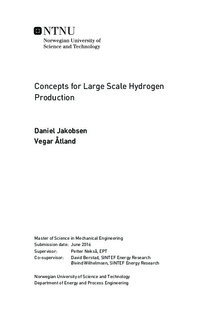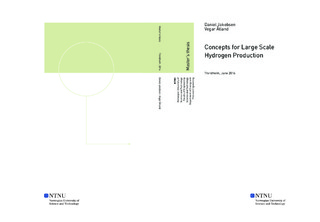| dc.description.abstract | The objective of this thesis is to perform a techno-economic analysis of large-scale, carbon-lean hydrogen production in Norway, in order to evaluate various production methods and estimate a breakeven price level. Norway possesses vast energy resources and the export of oil and gas is vital to the country s economy. The results of this thesis indicate that hydrogen represents a viable, carbon-lean opportunity to utilize these resources, which can prove key in the future of Norwegian energy exports.
This thesis evaluates six different systems for hydrogen production; Steam methane reforming (SMR), SMR using hydrogen as fuel in the furnace (SMR+), autothermal reforming (ATR), partial oxidation (POX), water electrolysis and a system combining electrolysis and ATR. Aspen HYSYS simulation tool is used to analyse the mentioned production systems. The simulations show that SMR and ATR produce hydrogen with the highest energy efficiency of 0.82. Although the efficiencies are similar, producing hydrogen with ATR reduces the emissions with 70% compared with SMR. SMR captures 3047 tonnes of CO2/day and emits 1198 tonnes/day, while producing 500 tonnes of hydrogen/day.
With a hydrogen production rate of 500 tonnes/day, SMR proves to be most cost-efficient, with a breakeven price of 1.51 /kgH2. In this method, CCS accounts for 0.32 /kgH2 of the total price. ATR produce hydrogen at 1.59 /kgH2, although with a smaller carbon footprint. A natural gas price of 0.17 /Sm3 and an electricity price of 20.03 /MWh is applied in the analysis. Given the same feedstock prices, electrolysis proves to be the most cost-efficient production system at capacities up to around 150 tonnes/day. When producing 100 tonnes of hydrogen/day, the breakeven price of electrolysis is 1.87 /kgH2 while SMR produces the hydrogen at 1.94 /kgH2. Based on early market predictions and given assumed development in distribution technology, hydrogen produced from all systems fully evaluated in this thesis can be cost-competitive in export scenarios.
A case study of hydrogen production combining ATR and electrolysis in Mid-Norway is performed to test the viability of utilizing excess wind power to reduce production cost. The results indicate that, given the boundary conditions in this thesis, a combined electrolysis and reforming system utilizing excess wind power is not likely to be cost-competitive with either stationary CRE powered by the grid or traditional reforming. | |

